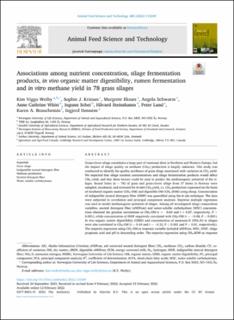| dc.contributor.author | Weiby, Kim Viggo Paulsen | |
| dc.contributor.author | Krizsan, Sophie Julie | |
| dc.contributor.author | Eknæs, Margrete | |
| dc.contributor.author | Schwarm, Angela Dagmar | |
| dc.contributor.author | Whist, Anne Cathrine | |
| dc.contributor.author | Schei, Ingunn | |
| dc.contributor.author | Steinshamn, Håvard | |
| dc.contributor.author | Lund, Peter | |
| dc.contributor.author | Beauchemin, Karen A. | |
| dc.contributor.author | Dønnem, Ingjerd | |
| dc.date.accessioned | 2022-07-11T10:13:31Z | |
| dc.date.available | 2022-07-11T10:13:31Z | |
| dc.date.created | 2022-04-23T22:11:31Z | |
| dc.date.issued | 2022-02-23 | |
| dc.identifier.citation | Animal Feed Science and Technology. 2022, 285 (115249), . | en_US |
| dc.identifier.issn | 0377-8401 | |
| dc.identifier.uri | https://hdl.handle.net/11250/3004515 | |
| dc.description.abstract | Grass-clover silage constitutes a large part of ruminant diets in Northern and Western Europe, but the impact of silage quality on methane (CH4) production is largely unknown. This study was conducted to identify the quality attributes of grass silage associated with variation in CH4 yield. We expected that silage nutrient concentrations and silage fermentation products would affect CH4 yield, and that these factors could be used to predict the methanogenic potential of the silages. Round bales (n = 78) of grass and grass-clover silage from 37 farms in Norway were sampled, incubated, and screened for in vitro CH4 yield, i.e. CH4 production expressed on the basis of incubated organic matter (CH4-OM) and digestible OM (CH4-dOM) using sheep. Concentration of indigestible neutral detergent fiber (iNDF) was quantified using the in situ technique. The data were subjected to correlation and principal component analyses. Stepwise multiple regression was used to model methanogenic potential of silages. Among all investigated silage composition variables, neutral detergent fiber (aNDFom) and water-soluble carbohydrate (WSC) concentrations obtained the greatest correlations to CH4-OM (r = −0.63 and r = 0.57, respectively, P < 0.001), while concentration of iNDF negatively correlated with CH4-OM (r = −0.48, P < 0.001). In vivo organic matter digestibility (OMD) and concentration of ammonia-N (NH3-N) in silages were also correlated to CH4-OM (r = 0.44 and r = −0.32, P < 0.001 and P < 0.01, respectively). The stepwise regression using CH4-OM as response variable included aNDFom, WSC, iNDF, silage propionic acid and pH in descending order. The stepwise regression using CH4-dOM as response variable included WSC, aNDFom and iNDF in descending order. Among in vitro rumen short chain fatty acids (SCFA), molar proportion of butyrate was the most prominent in increasing CH4-OM and CH4-dOM (r = 0.23 and r = 0.36, P < 0.05 and P < 0.01, respectively), while molar proportion of propionate was the most prominent SCFA in reducing CH4-OM and CH4-dOM (r = −0.23 and r = −0.26, respectively, P < 0.05). Regression models that account for silage quality attributes can be used to predict CH4 yield from silages with a coefficient of determination (R2) between 0.33 (CH4-dOM) and 0.65 (CH4-OM). In conclusion, concentration of WSC increased in vitro CH4-OM and CH4-dOM, while concentration of aNDFom and iNDF decreased CH4-OM and CH4-dOM in grass silages. | en_US |
| dc.language.iso | eng | en_US |
| dc.publisher | Elsevier B.V. | en_US |
| dc.rights | Navngivelse 4.0 Internasjonal | * |
| dc.rights.uri | http://creativecommons.org/licenses/by/4.0/deed.no | * |
| dc.title | Associations among nutrient concentration, silage fermentation products, in vivo organic matter digestibility, rumen fermentation and in vitro methane yield in 78 grass silages | en_US |
| dc.title.alternative | Associations among nutrient concentration, silage fermentation products, in vivo organic matter digestibility, rumen fermentation and in vitro methane yield in 78 grass silages | en_US |
| dc.type | Peer reviewed | en_US |
| dc.type | Journal article | en_US |
| dc.description.version | publishedVersion | en_US |
| dc.rights.holder | © 2022 The Author(s) | en_US |
| dc.source.pagenumber | 15 | en_US |
| dc.source.volume | 285 | en_US |
| dc.source.journal | Animal Feed Science and Technology | en_US |
| dc.identifier.doi | 10.1016/j.anifeedsci.2022.115249 | |
| dc.identifier.cristin | 2018635 | |
| dc.relation.project | Norges forskningsråd: 295207 | en_US |
| dc.source.articlenumber | 115249 | en_US |
| cristin.ispublished | true | |
| cristin.fulltext | original | |
| cristin.qualitycode | 1 | |

